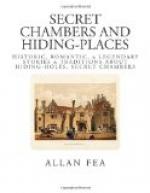There is a secret chamber at the old Cumberland seat of the ancient family of Senhouse. To this day its position is known only by the heir-at-law and the family solicitor. This room at Nether Hall is said to have no window, and has hitherto baffled every attempt of those not in the secret to discover its whereabouts.
Remarkable as this may seem in these prosaic days, it has been confirmed by the present representative of the family, who, in a communication to us upon the subject, writes as follows: “It may be romantic, but still it is true that the secret has survived frequent searches of visitors. There is no one alive who has been in it, that I am aware, except myself.” Brandeston Hall, Suffolk, is also said to have a hiding place known only to two or three persons.
CHAPTER XIII
CONCEALED DOORS, SUBTERRANEAN PASSAGES, ETC.
Numerous old houses possess secret doors, passages, and staircases—Franks, in Kent; Eshe Hall, Durham; Binns House, Scotland; Dannoty Hall, and Whatton Abbey, Yorkshire; are examples. The last of these has a narrow flight of steps leading down to the moat, as at Baddesley Clinton. The old house Marks, near Romford, pulled down in 1808 after many years of neglect and decay—as well as the ancient seat of the Tichbournes in Hampshire, pulled down in 1803—and the west side of Holme Hall, Lancashire, demolished in the last century, proved to have been riddled with hollow walls. Secret doors and panels are still pointed out at Bramshill, Hants (in the long gallery and billiard-room); the oak room, Bochym House, Cornwall; the King’s bedchamber, Ford Castle, Northumberland; the plotting-parlour of the White Hart Hotel, Hull; Low Hall, Yeadon, Yorkshire; Sawston; the Queen’s chamber at Kimbolton Castle, Huntingdonshire, etc., etc.
A concealed door exists on the left-hand side of the fireplace of the gilt room of Holland House, Kensington, associated by tradition with the ghost of the first Lord Holland. Upon the authority of the Princess Lichtenstein, it appears there is, close by, a blood-stain which nothing can efface! It is to be hoped no enterprising person may be induced to try his skill here with the success that attended a similar attempt at Holyrood, as recorded by Scott![1]
[Footnote 1: Vide Introduction to The Fair Maid of Perth]
In the King’s writing-closet at Hampton Court may be seen the “secret door” by which William III. left the palace when he wished to go out unobserved; but this is more of a private exit than a secret one.
[Illustration: WOODSTOCK PALACE, OXFORDSHIRE (FROM AN OLD PRINT)]
[Illustration: MARKYATE CELL, HERTFORDSHIRE]
The old Chateau du Puits, Guernsey, has a hiding-hole placed between two walls which form an acute angle; the one constituting part of the masonry of an inner courtyard, the other a wall on the eastern side of the main structure. The space between could be reached through the floor of an upper room.




